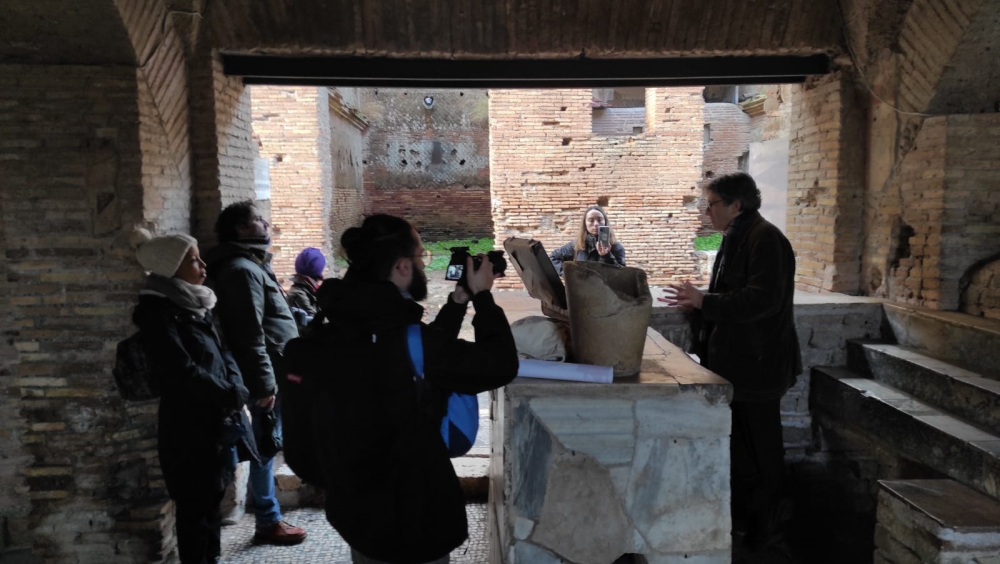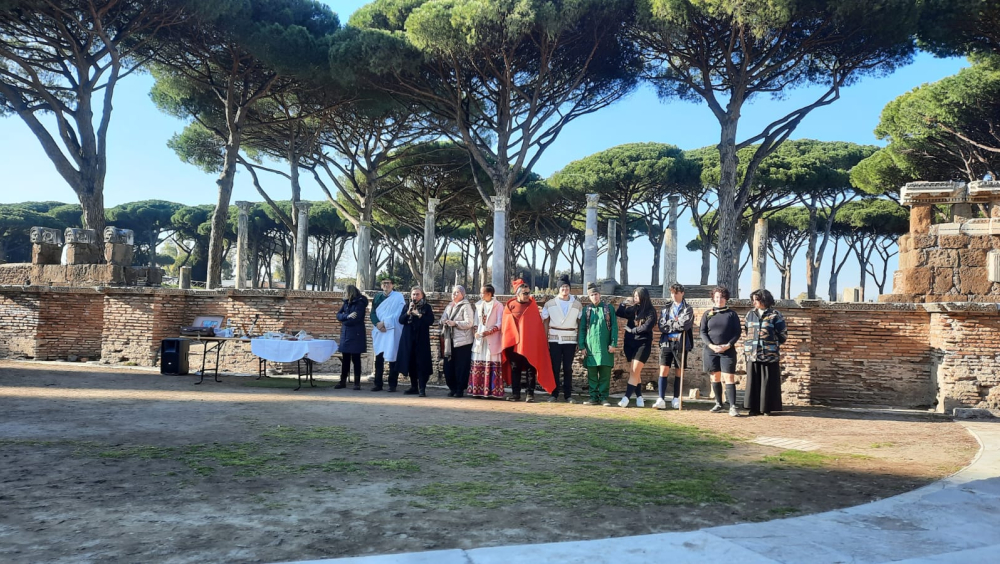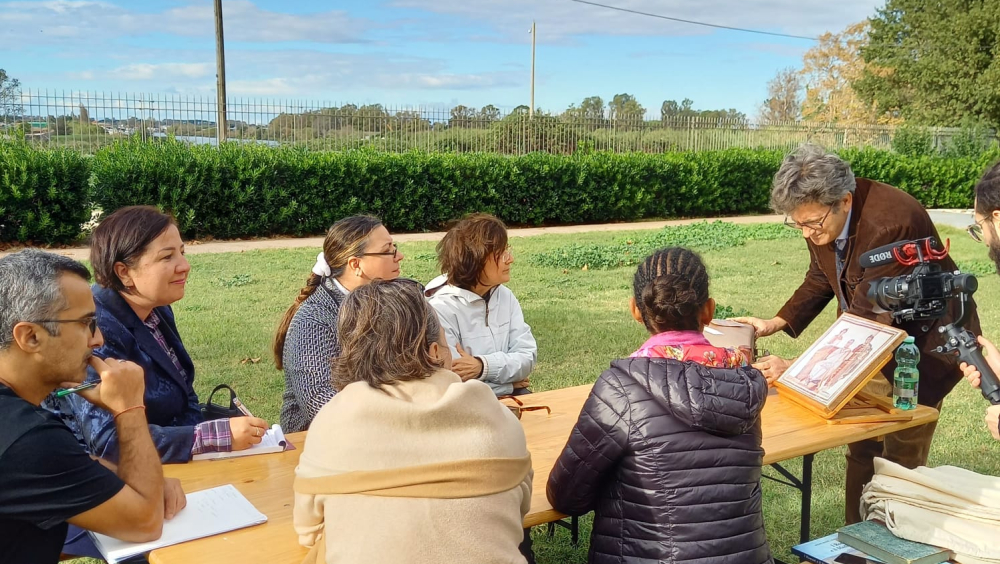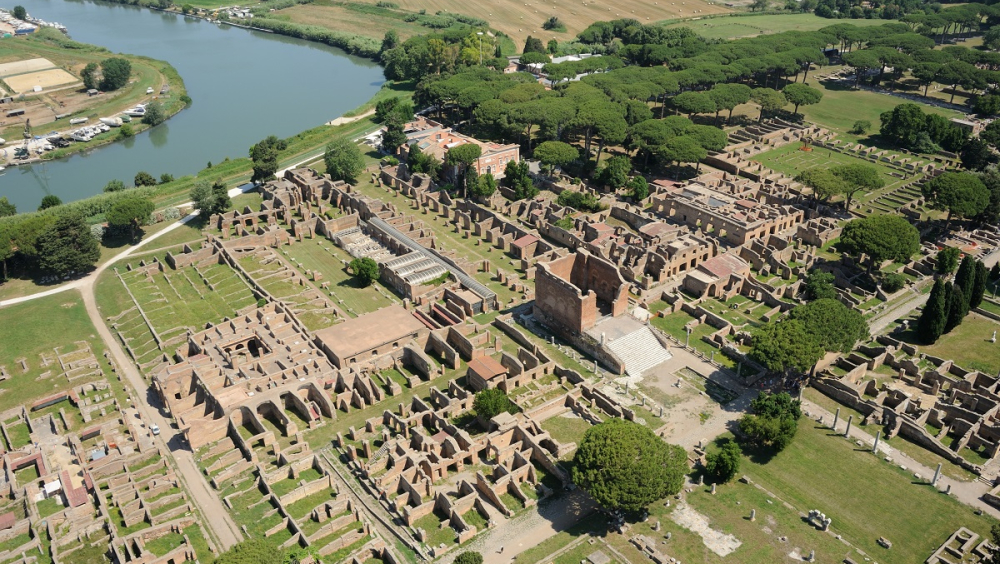Ostia antica città aperta - Public Archaeology in Ostia Antica
The Roman city of Ostia Antica was in the imperial age the 'gateway to Rome' towards which the maritime traffic of goods and people converged. We have to imagine that people from all parts of the Empire came to Ostia, each bringing their own culture, their own religious cults, their own goods, their own traditions. A true cultural melting pot of which traces remain in many monuments that tell us of places of commerce and exchange between merchants and ship-owners of different ethnic groups, of temples and places of worship that speak to us of different religions, and in the inscriptions that give us the names of people from all parts of the empire.
The vocation for international circulation is still alive in the area, thanks to the presence of Fiumicino Airport, which stands next to where the great port of imperial Rome once stood. And Ostia wants to strive again to be that open city it once was, it wants to involve the people who currently live in the territory, but who originate from other parts of Europe and the world: residents of the territory, but belonging to ethnic and linguistic minorities other than Italian. What do the ancient inhabitants of Ostia have in common with the current residents in the territory of Rome? The same need, today as then, to live together and to feel part of the same society: in Roman times it was the Empire, today it is Europe, and through actions of public archaeology we want to make the residents of ethnic and linguistic minorities aware and informed citizens of a past that belongs to all those who live here.
Two thousand years ago Rome was the centre of the world. The capital of the empire was a cosmopolitan city in which people from the most diverse parts of the then known world coexisted, each with its own ethnicity, language, culture, religious beliefs and deities. An open city, no doubt.
But all those people arriving in Rome by sea necessarily had to pass through Ostia.
It is no coincidence that Ostia means mouth: it stood at the mouth of the Tiber, the great river running through Rome, and was the first colony to be founded by the Romans when they began to expand beyond the borders of the Urbe.
Ostia was from then on considered the Gateway to Rome. And indeed it was: especially when the great Portus, the harbour immediately north of the mouth of the Tiber, was built, all those who came to the capital of the Empire by sea from all parts of the Mediterranean and the then known world passed through Ostia: sailors and ship-owners, merchants and travellers came from North Africa, Egypt, Asia Minor, Gaul and Spain, disembarked in Ostia and from there reached Rome.
On the streets of Ostia you would hear many different languages spoken, you would see many different gods praying, you would see people dressed in the most diverse ways; finally, in the shops, you would see the most diverse goods, such as oil from Africa, wheat from Egypt, wine from Gaul, garum - fish sauce - from Spain, spices from Asia Minor, marble from Greece. Ostia was a true cultural melting pot, which we can still perceive today thanks to the monuments and artistic and epigraphic evidence that tell us how multi-ethnic Ostian society was during the imperial age.
The construction of Portus, the great port located a few kilometres north of the mouth of the Tiber, in direct connection with Ostia, was the engine of this multi-ethnicity as well as, of course, the strategic infrastructure thanks to whose perfect functioning Rome was able to reach a population of one million and feed most of the population thanks to the cargoes of grain that arrived there daily.
The greatest commercial hub of antiquity, then. A place with a vocation for international circulation. A vocation that still exists, because immediately to the north of Portus today lie the runways of Fiumicino's Leonardo da Vinci International Airport. Today, as then, this territory sees thousands of people leave and arrive every day.
We asked ourselves whether this is the only thing in common between the past and the present. And we answered ourselves that there is more than just international circulation. Multi-ethnicity and multiculturalism are common elements in Ostia in Roman times and in Ostia (in Rome, in the whole of Italy) today. We want to put intercultural dialogue at the centre of the debate and our actions, and for this we have started a collaboration with the Scuolemigranti Association, which deals with ethnic-linguistic minorities and the teaching of Italian to foreigners. With Scuolemigranti we have started a project, which we want to pursue by extending it to other realities, in which our cultural heritage is made accessible to migrants, who are now to all intents and purposes residents in the area. A heritage that belongs to everyone who lives here.
We have already implemented a programme of meetings in 2022 to train people from ethnic-linguistic minorities, making them familiar with Ostia and enabling them to become cultural mediators in their own communities and families. The ethnic groups and nationalities that participated in 2022 were Romanian, Ethiopian and Iranian: Europe, Africa and Asia met and worked together, exactly as they did in ancient Ostia 2000 years ago.
In Italy, the issue of migrants and ethnic and linguistic minorities has been at the centre of a heated public, political and social debate for years now. The topic of social and cultural integration is very topical, but what role do museums play in this process? So far in Italy very few have thought of opening their doors to people from different cultures and ethnic groups, unless they are tourists. Instead, it is precisely to these people, who live here, who work here, who are residents equal to the 'Italians' that we want to open up, convincing them that the archaeological heritage of Ostia Antica is not a heritage that belongs to the Italians, but is the cultural heritage of all.
The European dimension of the project is expressed by the theme of intercultural dialogue, around which the whole project revolves: realising actions of public archaeology which, by talking about the past, provide tools to understand the present: reception, inter-religious dialogue, the circulation of goods, a single market, are all elements that within the project we tell and provide to the participants, so that they too feel part of a common cultural heritage.
The archaeological site of Ostia Antica has been awarded the European Heritage Label (https://culture.ec.europa.eu/cultural-heritage/initiatives-and-success-stories/european-heritage-label) precisely because of the values already expressed in the Long Description and because of the long-term project that it conducts on a daily basis: through our activities we develop the themes of multiculturalism, reception and integration in the ancient world to reflect them on the present. We do this through didactic activities aimed at school children, we do this through education to the common heritage thanks to a bilingual display board spread throughout the archaeological area and available digitally on our website, we do this through social content and openness to European and non-European scholars and research organisations. We will do this through an app in 11 languages, European and non-European, to make our heritage known far beyond our territorial, national and supranational borders.



